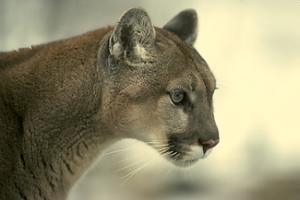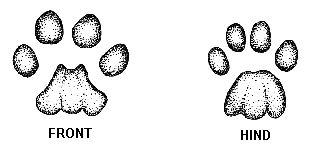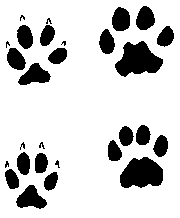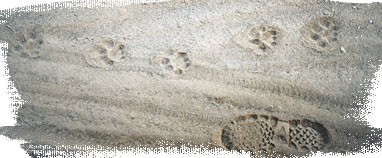
About half of California is prime mountain lion country. This fact is a surprise to many residents and visitors. These large, powerful predators have always lived here, preying on deer and other wildlife, and playing an important role in the ecosystem.
Also known as the cougar, panther or puma, the mountain lion is native to North America and exists only in the Western Hemisphere. A lion's natural life span is approximately 10 years in the wild and up to 25 years in captivity. The few natural enemies of the mountain lion include large predators such as bears, wolves and other lions. Mountain lions also fall victim to accidents, disease, road hazards and to people.
In California, some 5,000 mountain lions are estimated to inhabit the coastal mountains, northern forests, Sierra Nevada and southern deserts. An accurate census is impossible to make because the big cats are stealthy, roam enormous territories and are solitary.
APPEARANCE
Biologists call them Puma concolor, literally "cat of one color." Their coat is a plain, tawny brown, while their distinctive heavy tail measures almost two-thirds the length of head and body. The sexes look alike, but males are 30 to 40 percent larger. Males measure six to eight feet from nose to tail tip, compared with five to seven feet for females. A typical adult male weighs between 110 and 180 pounds.

Cougars have four toes on each paw and three distinct lobes at the base of each heel pad. Their front paws are larger than their rear paws. When walking slowly, mountain lions usually place their hind paw in the imprint made by their front paw. In a brisk walk or run, the hind feet overreach the front feet. Generally, claw marks are not visible since their claws are retractable. Cougars are solitary animals, and males almost always travel alone. Tracks indicated two or more lions traveling together would most likely be from a female and her kittens or a pair of siblings.

Dog on left .. Cougar on right

Cougar tracks .. probably young
Mountain lions produce a wide variety of sounds similar to house cat hisses, growls and mews. They are also capable of making high-pitched whistles and a vary piercing, drawn-out scream. Observations made on captive lions indicate that only females emit this scream, usually associated with mating.
HABITAT
Mountain lions are extraordinarily adaptable and can be found in every type of habitat in California. The big cats make their home from southern deserts to humid coast range forests, from foothill chaparral to the high desert and from sea level to 10,000 foot elevations in the Sierra Nevada. They are particularly fond of rocky foothill and mountainous areas that support populations of deer, elk, small mammals and large rodents.
With the exception of females and their kittens, mountain lions live alone, in home ranges (territories) that vary in size from 25 to 200 square miles. Adult males occupy the largest home ranges and females with young kittens occupy the smallest home ranges. The size of the home range depends on the terrain, vegetative cover and amount of prey available.
HUNTING AND FEEDING
Deer are the favorite prey of cougars, but they are opportunistic predators and will also kill elk, porcupines, small mammals, rodents, livestock and domestic animals. Mountain lions are most active from dusk to dawn, but they will hunt and travel in daylight.
Mountain lions are specialized carnivores who prefer to kill their own food. Like most cats, they take their prey by ambush rather than by a long pursuit. Lions usually stalk their prey, using available cover, then attack from behind. They usually kill with a powerful bite below the base of the skull, breaking the prey's neck.
A cougar will cover the carcass with dirt and leaves and will usually return to feed on it over the course of a few days. Generally, the carcass is moved and re-covered after each feeding.
MATING AND BREEDING
Mountain lions can breed year-round, but most births occur between April and July. Females generally begin mating at two to three years of age. Mating is one of the few times adult lions come together. After a male locates a female in heat, they will stay together only a few days while mating takes place. After a gestation period of approximately 90 days, the female will give birth to two to three kittens. Newborn kittens are about a foot long, weigh about one pound and their coats are covered with black and brown spots with rings around their tails..
Care of the kittens is the sole responsibility of the female. She will aggressively defend her young against male lions, who may kill them. Kittens remain with their mother for approximately 18 months. They learn hunting skills through play, exploration and by watching their mother. At six months, the kittens weigh over 30 pounds and have learned vital hunting skills. During the last months with their mother, the young will practice and improve these skills.
COUGAR/HUMAN ENCOUNTERS
Generally, mountain lions are calm, quiet and elusive. They are most commonly found in areas with plentiful prey and adequate cover. Such conditions exist on public lands, in mountain subdivisions, urban fringes and open space. As a result, the number of mountain lion/human encounters has increased. There are a variety of reasons for this increase: more people moving into mountain lion habitat, an increase in prey populations, an increase in mountain lion numbers and expanded range, more people using hiking and running trails in mountain lion habitat and a greater awareness of the presence of cougars.
The following guidelines and suggestions have been developed, based on reported patterns of behavior and response. Remember: Every situation is different and a cougar's individual behavior can be affected by several factors including the terrain, the people and their activity, as well as the age and health of the mountain lion.
When you hike in mountain lion country, go in groups and make plenty of noise to avoid surprising a lion. Keep children close and within sight at all times. Talk with children about lions and teach them what to do if they meet one.
Never approach a cougar, especially one that is feeding or with kittens.
If you come upon a cougar, stay calm. Talk firmly to it and move slowly. Most mountain lions will try to avoid a confrontation, so give it a way to escape.
Stop. If it is safe, back away slowly. Do not turn your back and do not run. Running will stimulate the cougar's instinct to chase and attack. Face the cougar and stand up straight.
Do all you can to appear larger. Raise your arms and open your jacket it you're wearing one. If small children are with you, pick them up so they will not panic and run.
If the cougar behaves aggressively, throw stones or anything you can reach without crouching down or turning your back. Wave your arms slowly and speak firmly.
Fight back if the cougar attacks. Unlike with bears, "playing dead" does not work. Cougars have been driven away by prey that fights back. People have successfully fought off lion attacks using such objects as rocks, sticks, clothing, garden tools and even their bare hands.
Like any wildlife, cougars can be dangerous. There is a responsibility that comes with recreating on public lands. With a better understanding and respect for these majestic animals, we can peacefully coexist with the mountain lion.
For more information about mountain lions and how to identify their tracks, check the following site http://www.bear-tracker.com/caninevsfeline.html
For a whole lot of information on tracking of all types check http://www.bear-tracker.com/